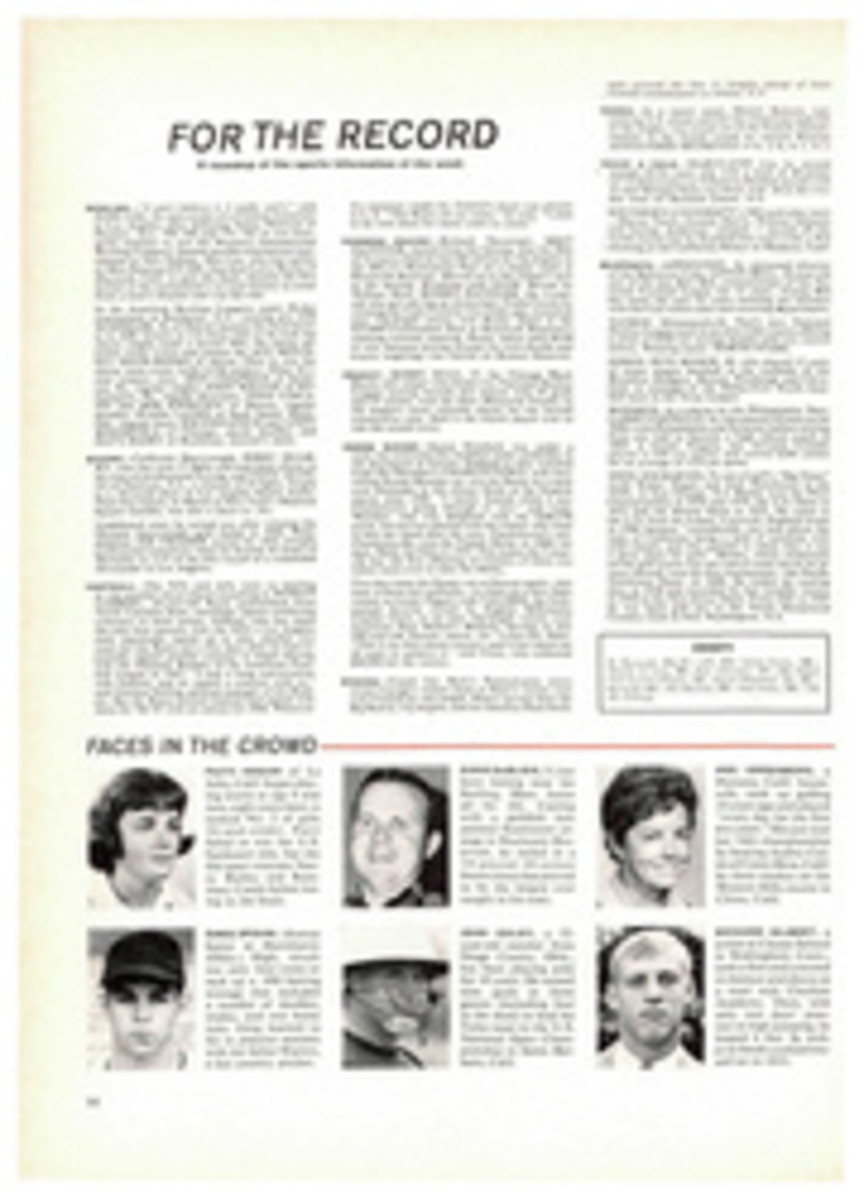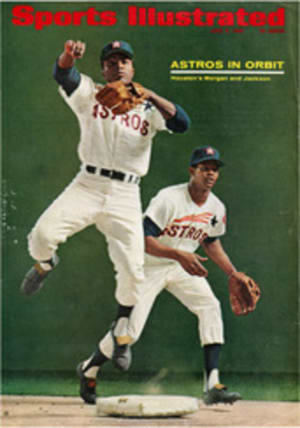
Three bright young businessmen from Wyoming with a lot of irons in the fire
You may have a million acres of ground and a lot of cows, but you ain't got much till you got a brand." So goes an old cowboy saying.
You had to have a brand way back in the days of ancient Egypt if you didn't want some ornery, good-for-nothing rustler to make off with your cattle or slaves. And, centuries later, one of the first cattlemen in the Americas, Hernando Cortés, conqueror of Mexico, had to have a brand for his livestock. He used three Christian crosses.
In the open-range days of what is fondly known as the Old West branding irons were vital. There were running irons (a red-hot iron with a blunt point used as a stylus to trace a brand on the hide of an animal) and stamping irons with fixed designs. They were and are the real American heraldry. Instead of eagles and rampant lions, or fleur-de-lis, griffins or wyverns, these American heraldic designs are indigenous and understandable things, such as coffeepots (upright with lid closed, upright with lid open, lying on the right or left side, tilted or upside down), bridle bits, bootjacks, butterflies, teapots, knives, lamp chimneys, shovels, hats, umbrellas, tepees, turkey tracks, warbonnets and a host of other familiar objects. A good brand should be simple, big enough to read at a distance, suggestive of a name if possible (to make it easier to remember) and, finally, it should not blotch—this last to discourage rustlers, who might want to alter it.
When fences came along, a lot of people thought brands might not be needed any longer, but it turned out that with more cattle and more people raising cattle even more brands were needed to thwart rustlers. Today cattle states still have thousands of registered brands. Wyoming alone has 22,466 registered in the Brand Division of the Livestock and Sanitary Board in Cheyenne.
The official state brand books probably will not grow much larger, but there are soon going to be more branding irons around the U.S. than there are cows. They are in demand as decorative pieces for dens and patios and as novel pokers for fireplaces and outside grills. They can also be used to brand your leather goods, your steak or a piece of pine board for a gate or door sign. Said one grizzled old Colorado cowpuncher: "The dudes'll be branding the left rear fender of their shiny station wagons next thing you know."
To meet the demands of collectors of western Americana, three bright young men have a brand-new brand business going in the little town of Lusk (pop. 1,890) in eastern Wyoming. Under the firm name of The Blacksmith, 242 Rawhide Avenue, they are turning out 200 branding irons a day. They are using old Wyoming brands but will make brands to order or will even design them for the discriminating 1966 condominium cowboy who must have one of his very own. Prices range from $3 to $18.
The three young men are Paul Holtz, 32, administrative assistant to Wyoming's Governor Clifford P. Hansen, James B. Griffith Jr., 39, editor of The Lusk Herald, and Dr. Lawrence McGarvin, 31, a dentist, who sometimes worries about what his patients will think when they find out he is also in the blacksmith business. The trio got the idea of making branding irons while having coffee one morning in the Ranger Hotel in Lusk. The town had been losing payrolls lately. The telephone company automated and let out 18 operators. A couple of other businesses, including a creamery, were in the process of moving away. What could they do or make that would tie into the Old West and still not duplicate what someone else was doing? Then someone thought about branding irons, authentically made and ready for decoration or use.
The trio went to see W. W. (Buck) Culver, a 56-year-old real, honest-to-goodness blacksmith who runs the Western Repair Shop, the only automobile and truck spring manufacturer in the state. Buck has three men and a woman in his shop and does just about everything except shoe horses. He keeps a stock of different-size horseshoes for the convenience of neighboring ranchers and farmers, but he hasn't done any shoeing himself since he was laid up after trying to put a shoe on a fractious bronc. Buck and his helpers (one of them, 74-year-old John Mudra, has been pounding away at metal since 1910), make gate hinges, grillwork, trailers, branding chutes, rustic door latches and fireplace sets, as well as automobile and truck springs.
Buck listened to the three young would-be purveyors of branding irons, shook his head and said: "I've made hundreds of branding irons for cows, calves, horses and sheep, but never for dudes. Oh, well, here we go again."
A proper sort of stamping iron customarily has a handle about two and a half feet long. The letters, numerals or figures are usually about four inches high. Quarter-inch to half-inch iron is generally used, since the best branding iron is one that will hold heat well and still leave a neat mark. Most brands consist of a combination of two or three characters, though some have only one and some have as many as four.
After a little experimentation the Lusk entrepreneurs decided to make their irons out of "mild steel" pounded down from three-eighths of an inch to three-sixteenths. Each iron is handmade and is somewhat neater than the early-day monsters created by blacksmiths in what Buck Culver calls the B.W. (before welding) period. The long handles taper toward the business end for the proper transfer of heat.
It is enough to make a cattleman blush, but just for the heck of it the new firm has turned out some chrome-plated branding irons. "They look like a million dollars," Jim Griffith says with a grin. "But they are worthless if you want to brand anything. They won't heat."
The "authentic reproductions" weigh approximately two and a half pounds and are 35 inches long. Most of them are fairly simple—diamonds, circles, hearts, the box and the open box, rockers and other old favorites. But those who want a special brand can have it, along with a parchment certifying that it has been registered with the Rawhide Brand Association in Lusk. Most brands made thus far have been aged with salt water. "To make them even more genuine we are considering doing some of the aging by using cow chips," Dr. McGarvin says.
The firm is also experimenting with miniature branding irons similar to the small, personalized steak brands made by Sloan Brands in Saginaw, Texas. The miniature has a handle 10 to 11 inches long and is designed to be heated in the coals of a grill and used on a steak.
Griffith and his associates have adopted a slogan, "The All-American Coat of Arms," and have printed up wholesale price lists for the states of Colorado, Idaho, Utah, Montana, Wyoming, Nebraska and South Dakota. Two salesmen are out on the road visiting gift shops and similar places that handle western curios.
The three owners of The Blacksmith have solid western backgrounds. All three are natives of Wyoming. Dr. McGarvin, a graduate of the University of Nebraska dental school, was born in Worland, Wyo. His parents ranched and farmed near there for many years, and his maternal grandfather was a sturdy Scots sheepman who migrated to the United States and settled in Wyoming in the early part of the century to run sheep in northern Wyoming. Griffith's maternal grandfather, Harry Snyder, came up the trail from Texas in 1879, married the pretty schoolteacher, just like they do in song and story, and helped organize Niobrara County (Indian for "running water"), of which Lusk is the county seat. Holtz, a crew-cut, solidly built young man, was born in Lander, the son of a Hopkins-trained physician who has practiced in Wyoming since he was first attracted to the state by big-game hunting in 1928. While Paul was a journalism student at the University of Wyoming he was managing editor of the student newspaper for two years running. Its name: The Branding Iron.
"Some of the older ranchers are frowning a bit at our new business," Holtz says. "Will they ever be surprised when Lusk becomes the branding-iron capital of the world."

